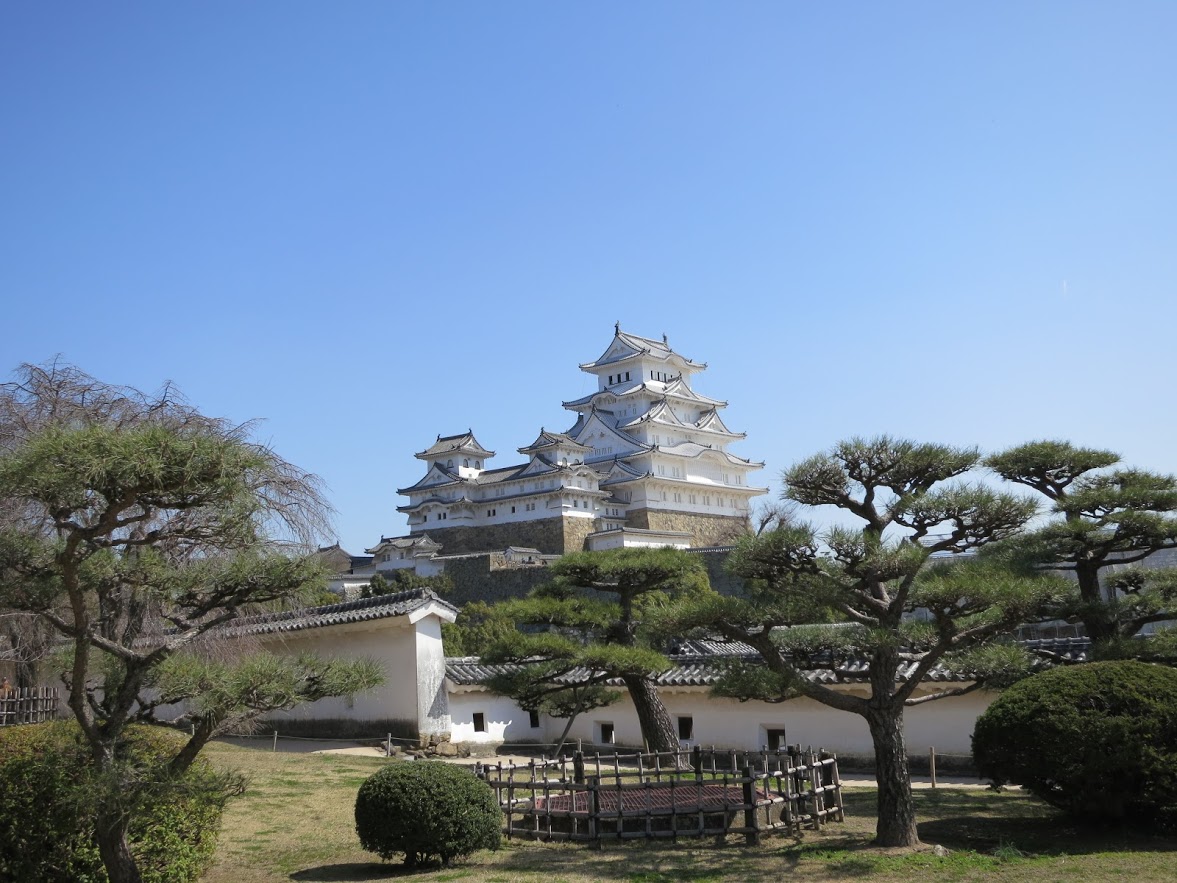Himeji Castle is in a word, magnificent. Sitting atop its stone base, it rises like a bird stretching its wings towards the sky, like a great white heron as its namesake suggests. Strange to say that this picturesque building so famous as Japan’s most famous castle has no single image of a heron in it. The feudal symbol of the lord of this place was, instead, a butterfly. Not a ferocious beast like a dragon or a griffon, but in Japan such a thing still holds power, and there is no mistaking the power of Himeji Castle.
Picture the classic European castle and you might imagine a large, brooding stone fortress with a drawbridge, high cornice towers, dungeons full of terrible implements, maybe even a fantastical dragon and a princess in the highest parapet. Such fantasies and realities define the castles of many youths, but in Japan is not only a fortress, it is a thing of beauty. It has sleek stone walls, all perfectly symmetrical, support wide arching roofs of black tiles that create a contrast to the white stone beneath them. On the tallest points, one finds the trademark “Dolphin fish” meant to ward off lightning and fire.
Of course, there can’t be a castle without a ghost story, a bit of a fantastical and sad element to this beautiful place. Himeji Castle has such a specter, the ghost of a beautiful servant named Okiku. You can read the sad story here but the tale involves the familiar veins of love, betrayal, and ultimately Okiku is thrown down the well. To this day there is a story of a soft, whispered voice of the servant as she counts dishes down in the well, or the figure of an ethereal woman floating around it.
Ghost or not Himeji castle is a perfect example of beauty in ferocity and perfection along with imperfection, a distinct Japanese aesthetic. Look here and there and you can find subtle imperfections in a roof tile end being upside down, one tower being slightly askew from the lines and size of another, or the shape of paths. Some of these are functional, creating narrow choke points for invaders and allowing the castle defenders a better option for attack. The castle never faced intrusion however, and it is one of the longest standing examples of its kind.
Like many structures, the castle has been constructed and reconstructed over the centuries. The last time was just before World War II when artisans reconstructed the whole superstructure with new wood. Such refurbishment is essential in such a wet, humid climate where wood rots quickly, but the people who maintained the castle were so good at their job that the visitor could imagine it hasn’t changed in centuries. When we arrived the castle had just undergone a renovation that restored the white coloring that gives its distinctive color, a coloring created with a form of seaweed.
The castle itself has no bad view towards it, and now bad view away from it. It dominates the town that grew up at its foot, but even from the furthest reaches where the noblewomen maintained the lord’s court, one has a view of the keep. Going in early spring, there were not as many flowering cherry trees, but this place is famous for its sakura blossoms in view of the building. Even at our perspective day, there were enough blossoms to add a hint of pink color to contrast the whites and blue-blacks.
Himeji Castle’s city bears little resemblance to the castle, a modern metropolis with buildings and shopping streets lining the main road. My parents and I enjoyed a walk down some of these lanes, including a brief stop to watch a man rolling out soba noodle dough in the front window of his shop. When we paused to watch, he grinned at us and flashed two fingers to indicate when his shop opened. We never got a chance to sample his soba, but I made a mental note to come back someday and try.
One has plenty to see of the castle’s exterior, but I would also say the interior is worth a visit. My family and I were warned that there wasn’t much to see inside the castle. We heard warnings that the interior was just “empty rooms” but even these empty rooms held mystery and majesty. There was a sense of how things work, how the castle is built and plenty of exercise as we climbed many -very- narrow stairs. Yes, unfortunately, there is no wheelchair access into the keep’s main tower turret and there is no easy escalator. Sorry.
Overall Himeji Castle and City are well worth a visit, a definite day trip or an overnight stay. It’s conveniently located along the Shinkansen route to the west, and just a half hour from Osaka and some other major cities. If you are going to Japan, I would highly suggest that this castle is an appointment that you keep
















No comments:
Post a Comment